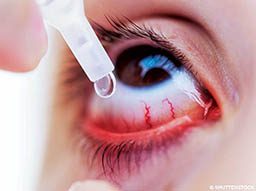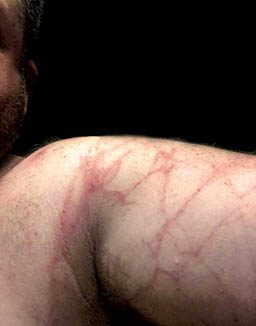What is the mammalian dive reflex?
The mammalian diving response, or “dive reflex,” is the way our body automatically prioritizes blood delivery to the brain and heart when we hold our breath underwater. When your head is underwater, you are using up the oxygen in your blood and not replacing it by breathing, a condition known as hypoxia. The brain and the heart are exceptionally sensitive to hypoxia, whereas other parts of our body, such as our arms and our legs, can tolerate hypoxia much more easily.

Immersing your face in cold water triggers the trigeminal nerve (also called the fifth cranial nerve) in your face and sends signals to the brain. The brain then activates the vagus nerve (or 10th cranial nerve), which is part of the autonomic nervous system. The autonomic nervous system helps control things such as our heart rate and breathing without us having to think about it. The vagus nerve slows down the rate at which our heart beats; when it beats more slowly, it doesn’t need as much oxygen to function.
Simply being immersed in water creates a hydrostatic pressure effect on the body that essentially squeezes some of the blood from our extremities back toward our heart. The vagus nerve also causes certain blood vessels to constrict (called vasoconstriction), subsequently pushing even more blood from our extremities back toward our heart and brain. Immersion of your face in cold water or breath holding can cause these effects, but they are much more pronounced if you hold your breath while also immersing your face in cold water.
Interestingly, there is also a response by our spleen to breath holding underwater. Red blood cells carry oxygen in our blood to our tissues. Extra red blood cells are stored in the spleen and can be added into the blood circulation during times of stress — such as hypoxia, bleeding and strenuous exercise — by the action of splenic contracture. Extra red blood cells allow more oxygen to be carried to where we need it. Some populations of indigenous breath-hold divers, such as the Bajau of Southeast Asia, have developed larger spleens and thus a larger reservoir of red blood cells and better tolerance to hypoxia. Conversely, we don’t see this effect in people who have had their spleen removed.
All diving mammals experience these dive reflexes, although in humans it is less intense than in diving animals. Elephant seals, for example, can dive to more than 5,000 feet holding their breath and during migration can spend more than 80 percent of the time underwater. Researchers tracked an elephant seal that breath held to more than 4,000 feet for two hours.
Whether you fall into the water by accident or you are holding your breath for competition, your brain and heart need oxygen. While we may not be as adept as the elephant seals, you can see how the dive reflex helps to ensure our brain and heart get the oxygen they need when we hold our breath underwater.
— Kaighley Brett, M.D.
Two days ago I was diagnosed with conjunctivitis (pink eye). My doctor prescribed antibiotic eyedrops that I have been using as directed. I am supposed to go diving this weekend. Can I dive while using these drops?

Antibiotics, whether drops or pills, are not known to be an issue with diving. It is the illness or condition being treated that is always the greater concern. It would be best to wait until the conjunctivitis is completely resolved. Diving is possible if you are physically comfortable enough and have clear vision. Keep in mind that water at the dive site, especially seawater, can be irritating. After you finish diving, you need to clean and disinfect your mask so there is no risk of reinfection. To prevent transmission of conjunctivitis to other divers, do not let anyone else handle your mask, and do not wash it in a communal wash basin.
— Marty McCafferty, EMT-P, DMT
About an hour after I completed a single drysuit dive on air, I noticed odd bruise-like lines on both shoulders and behind both knees, but no other symptoms. The uneventful dive was to 65 feet for 24 minutes in a lake with a water temperate of 50°F. The drysuit was tight, however, around the shoulders, armpits and knees. How would I know if this is skin bends or suit squeeze?

When differentiating between drysuit squeeze and the many causes of diving-related skin conditions, we can quickly eliminate most types of marine life injuries simply because the skin is completely covered by the suit. Cutaneous decompression sickness (DCS), or skin bends, is a mild form of DCS. Drysuit squeeze is a type of barotrauma or pressure injury to the skin that is caused by a failure to add air to your drysuit during descent.
While descending, the volume of the air spaces is reduced and trapped in the folds of the suit. The skin tends to be sucked into these folds. Divers will often recall the suit being tight or ill-fitting. The diver may find linear marks or bruises, usually beneath the drysuit’s valves and seams. This condition is usually painless and clears within a few days. To avoid suit squeeze, divers should add just enough gas to the suit during descent and make sure to vent excess gas when ascending.
Cutaneous DCS typically presents as a blotchy, bruise-like rash generally appearing in areas of the body with the most adipose tissue (body fat), such as the abdomen, thighs, buttocks and breasts. The condition usually responds well to surface-level oxygen therapy. DAN has observed, however, that at least 20 percent of divers with suspected skin bends may also experience visual disturbances, weakness, confusion or other neurological symptoms that require recompression treatments. It is important that divers do not overlook these symptoms. DAN always recommends a thorough medical evaluation and appropriate treatment of divers with suspected skin bends.
— Travis Ward, EMT-P
My 15-year-old son is interested in scuba diving. While vacationing in a mountain range two years ago, he developed altitude sickness. He was treated quickly, recovered well and has had no problems since. An experienced diver told me that my son could be more prone to decompression sickness because he has had altitude sickness. Is he really at greater risk?

The short answer is no. The physics of being at altitude and being at depth are opposite each other. Exposures to less atmospheric pressure, such as being in the mountains, affect human physiology differently than when exposed to increased atmospheric pressure, such as with diving. There is no connection between the two illnesses. If your son is physically fit and healthy, there is no reason for him to be more concerned with decompression sickness than any other diver.
— Marty McCafferty, EMT-P, DMT
| © Alert Diver — Q3 2018 |